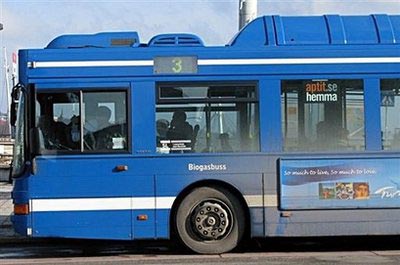Buses run by garbage
Since 2010, clean buses will roll on the streets of Oslo (Norway), with biofuels produced from waste like mud, sewage and leftovers.

Buses use biofuels in Sweden.Photo: AFP.
'The new bus will help us reduce many things like CO 2 emissions, garbage, noise and sewage,' Ole Jakob Johansen, an official in charge of the biofuel bus project. Oslo said. Data on buses used are methane generated from mud and sewage. The Bekkelaget waste treatment plant - which receives the waste of 250,000 people in the city - will provide materials to produce methane.
'Everyone's bathing for a year creates about 8 liters of diesel. That number is not large, but if multiplied by 250,000, we will have enough fuel to 80 buses running 100,000 km per vehicle , 'Johansen said.
Using bio-methane is a leap in terms of environmental protection. In addition to reducing carbon emissions, buses using bio-methane generate less nitrous oxide (78% reduction) and micro-particles pollute (down 98%) than diesel-powered buses. Their noise level also decreased by 92% compared to traditional buses.
Johansen said the cost of producing biofuels is lower than diesel. It takes only 0.72 euros to produce methane equivalent to a liter of diesel, while the price of one liter of diesel in addition to Norwegian gas stations is more than 1 euro.
'Bio-methane is cheaper, but the cost of buying new buses and maintaining them will be higher. If the cost of methane production, car buying and maintenance is included, the cost for buses running biofuels will be 15% higher than for traditional buses, 'said Anne-Merete Andersen, system administrator. Oslo city public transport, commented.
Unlike bio-ethanol (made from cereals and plants), bio-methane does not reduce food production. It also does not need water sources in the production process such as bioethanol. Environmental organizations are excited when officials announce the project in Oslo.
'We have been waiting for this for a long time. This is a project that both contributes to protecting the environment and improving the quality of urban life. I saw a bus using biofuels without any weaknesses. On the contrary, it shows us that people always have ways to take advantage of what we leave, 'said Olaf Brastad, a leader of Bellona.
If Oslo's second waste treatment plant is involved in the project and the amount of waste food is turned into biofuel feedstock, the amount of methane the city produces can supply 350 to 400 buses operate. According to experts, with 400 buses using bio-methane, CO 2 emissions will be reduced by about 30,000 tons per year.
Earlier, biofuel buses appeared in many European cities like Lille (France) and Stockholm (Sweden).
- More than half of public buses will become electric buses in 2025
- Video: Sweden launches the first self-propelled bus model
- How does the bus in the river work?
- China tested unmanned buses
- South Korea successfully built the 'amphibious' bus running underwater
- The longest bus in the world
- How does Japan handle garbage security?
- How to sort garbage at home, you know?
- Hong Kong charged the garbage tax
- Start the bus test run
- The only country in the world falls into a shortage of garbage
- Turn garbage in the universe into radiation shield
 Is the magnetic North Pole shift dangerous to humanity?
Is the magnetic North Pole shift dangerous to humanity? Washington legalizes the recycling of human bodies into fertilizer
Washington legalizes the recycling of human bodies into fertilizer Lightning stone - the mysterious guest
Lightning stone - the mysterious guest Stunned by the mysterious sunset, strange appearance
Stunned by the mysterious sunset, strange appearance The world's first self-driving bus began operating in Scotland in May
The world's first self-driving bus began operating in Scotland in May  How does the bus in the river work?
How does the bus in the river work?  Video: Technology turns the road surface into a power source for buses
Video: Technology turns the road surface into a power source for buses  More than half of public buses will become electric buses in 2025
More than half of public buses will become electric buses in 2025 